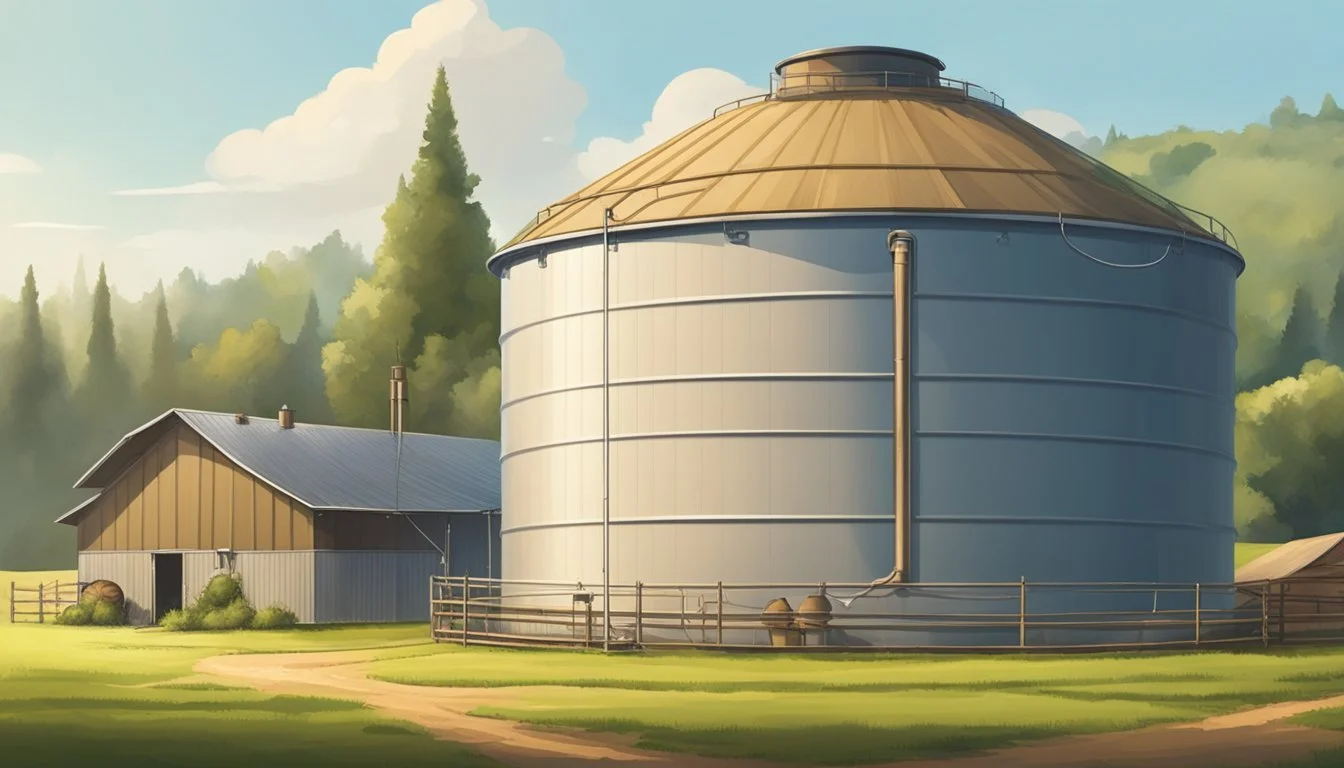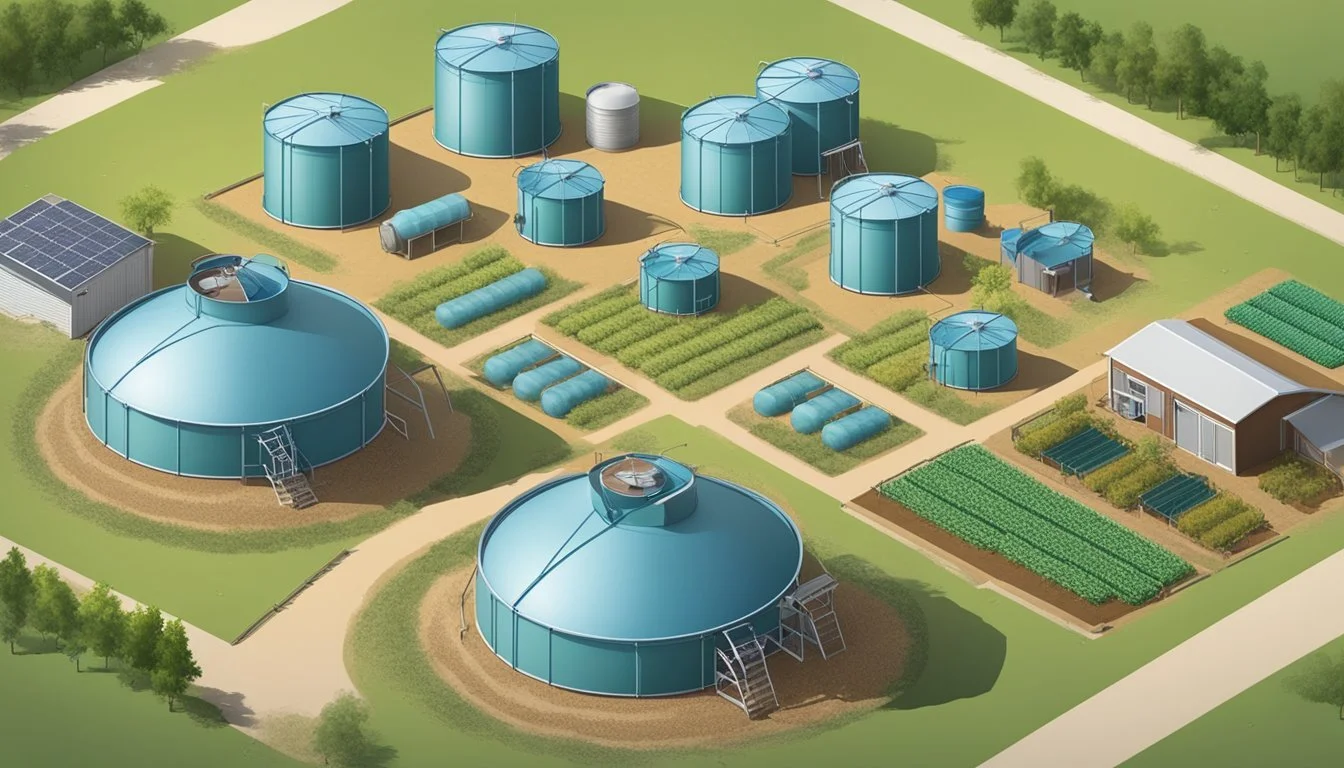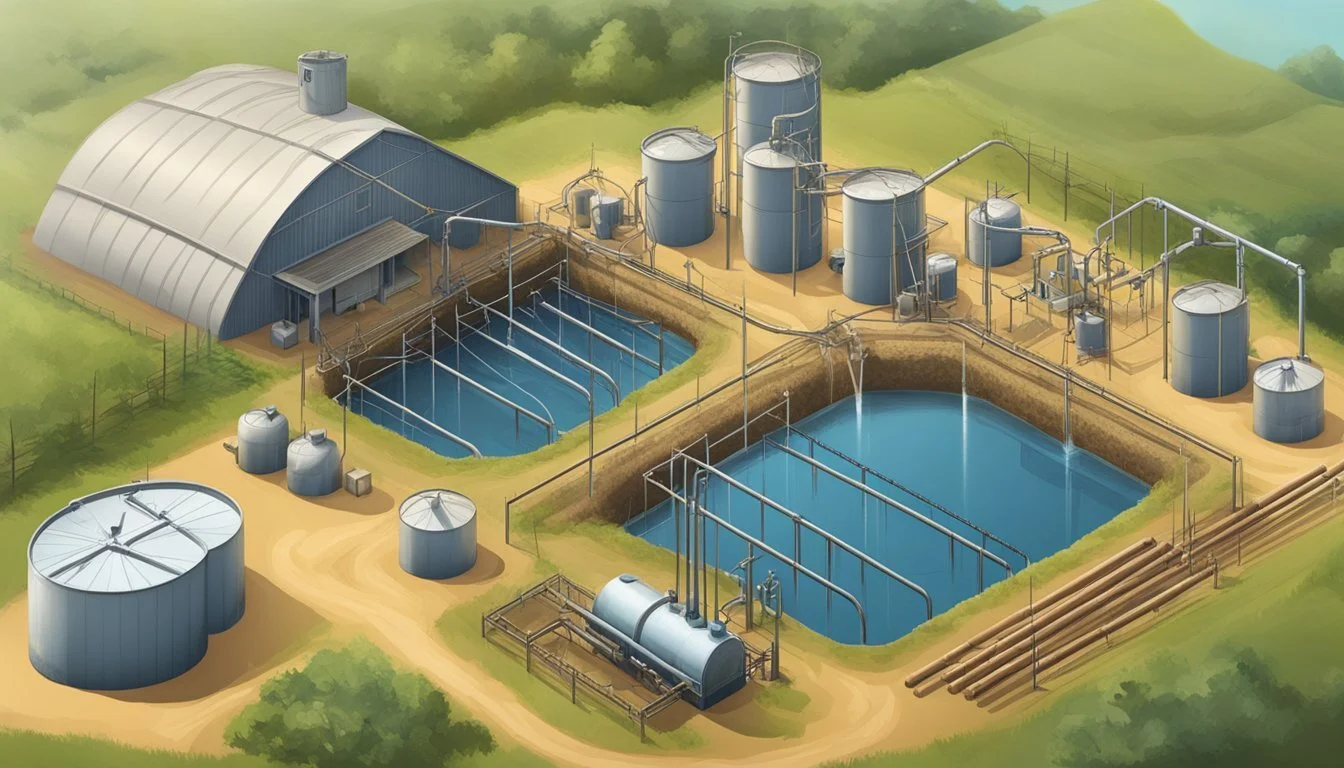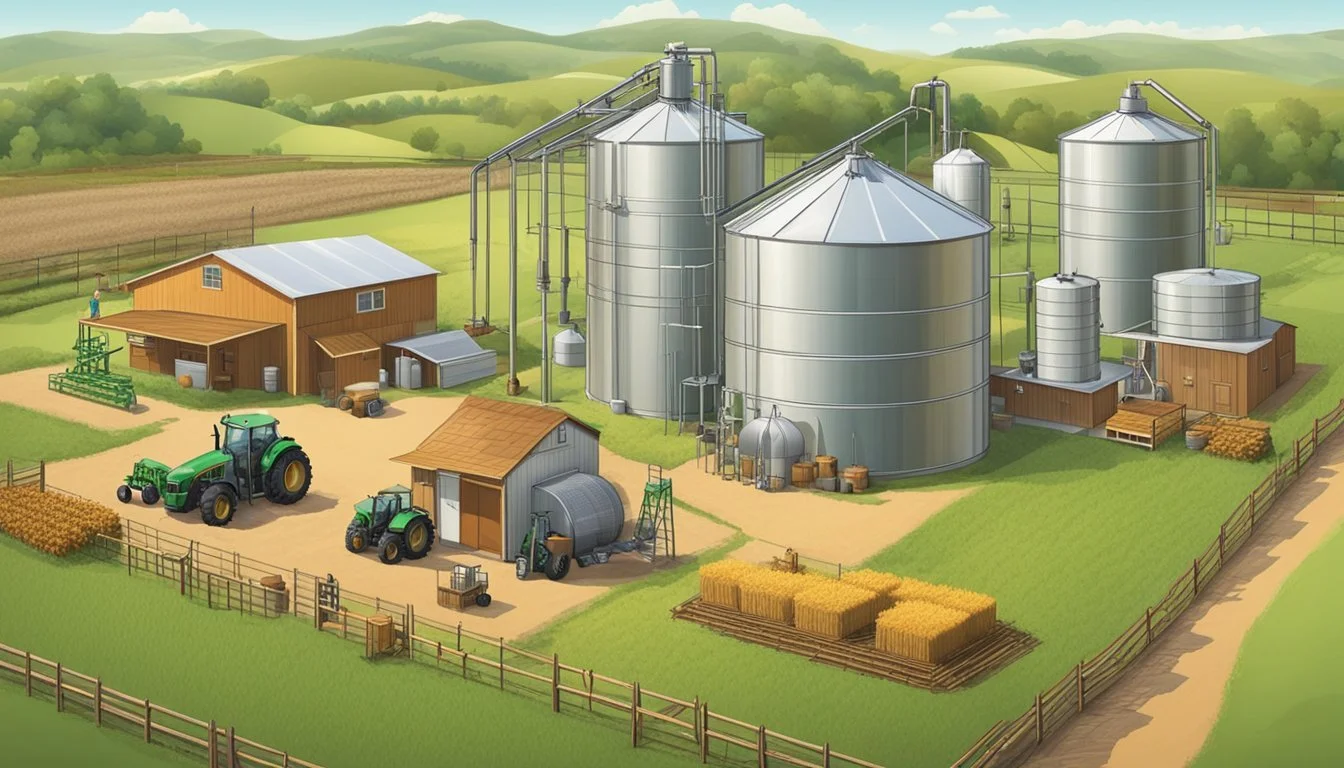The Ultimate Guide to Water Storage Tanks
Essentials for Homesteading Irrigation and Livestock Needs
Water storage tanks play a vital role in the sustainability and efficiency of homestead operations, particularly when it comes to irrigation and providing water for livestock. These systems serve as the backbone of water management on any agricultural property, allowing for the collection and storage of life-sustaining water. Homesteaders rely on these water reserves for keeping their crops healthy and ensuring their animals have a reliable supply of water, an absolute necessity for their well-being and productivity.
The selection and maintenance of appropriate water storage solutions is a complex decision that depends on numerous factors, including the size of the property, the types of crops grown, the number of livestock, and the climate. Effective rainwater harvesting and storage not only cut down on utility costs but also provide a measure of security against drought and water supply disruptions. It also plays a key role in the responsible management of this precious resource, ensuring that every drop of rainwater is put to good use.
With a range of options available, from simple barrels to sophisticated gravity-fed systems, homesteaders can customize their water storage to meet their specific needs. Understanding the fundamentals of rainwater collection and the components of these systems—such as first-flush diverters, water level indicators, and purification measures—is crucial for both new and experienced homesteaders. This guide walks through the essential considerations and provides insights on how to implement and optimize water storage tanks for both irrigation and livestock watering.
Understanding Water Storage Needs in Homesteading
In homesteading, water storage is a vital component for ensuring a reliable water supply for both irrigation and livestock watering. This section will discuss how to evaluate specific water needs, the importance of sustainable sources, and the potential impacts of inadequate water storage.
Evaluating Water Requirements
Homesteaders must first quantify their water needs. This involves assessing the volume of water necessary for irrigation and livestock watering demands. The calculation should consider:
Crops' water needs: Different crops require varying amounts of water, often dependent on stage of growth and climate conditions.
Livestock water consumption: Specific water intake requirements depend on the animal type, size, diet, and environmental temperatures.
Table 1: Average Daily Water Requirements
Cattle: 12-20 gallons per day
Sheep: 2-3 gallons per day
Pigs: 3-5 gallons per day
Chickens: 0.1-0.2 gallons per day
Importance of Sustainable Water Sources
Homesteaders should prioritize sustainable water resources to maintain a consistent water supply. Options include:
Rainwater harvesting: Collecting and storing rainwater reduces reliance on external sources and helps in water conservation efforts.
Well water: A private well can be a long-term investment providing a steady source of water.
The choice of a water source should aim for minimal environmental impact while ensuring water availability during dry periods.
Consequences of Inadequate Water Storage
A lack of proper water storage can lead to dire consequences for homesteading activities:
Crops may fail due to insufficient irrigation during critical growth stages.
Livestock health could be compromised if water scarcity leads to dehydration, affecting productivity and well-being.
Ensuring adequate water storage mitigates these risks and supports the homesteader's goal of self-sufficiency.
Types of Water Storage Tanks
Choosing the right type of water storage tank is crucial for irrigation and livestock watering in homesteading. The material and structure of a tank affect its durability and suitability for different water storage solutions.
Polyethylene Tanks
Polyethylene tanks, made of high-density plastic, are a popular choice due to their lightweight design and resistance to impact. These tanks can withstand various chemicals and are suitable for potable water. They come in various sizes and are often used for both small-scale and large-scale operations.
Key Features:
Material: Durable high-density polyethylene
Durability: Resistant to impact and a variety of chemicals
Sizes: Ranging from small to thousands of gallons
Concrete Tanks
Concrete tanks offer longevity and robustness, making them ideal for long-term water storage needs. They are well-suited for underground installations, as their weight and structure allow them to handle the pressure of being buried without collapsing.
Key Features:
Material: Reinforced concrete
Durability: High durability and suitable for underground installation
Structure: Heavy and permanent
Metal Tanks
Metal tanks, including steel variants, serve for various water storage needs. Corrugated steel tanks are especially favored for their strength and expandability, with capacities that can reach up to 1 million gallons. They can be used for rainwater harvesting, fire protection, and irrigation.
Key Features:
Material: Steel (including stainless and galvanized)
Durability: Strong and capable of handling large volumes
Capacity: Up to 1 million gallons
Fiberglass Tanks
Fiberglass tanks are non-corrosive and suitable for storing an array of liquids including potable water, wastewater, and stormwater. Their non-porous surface prevents algae growth and makes them easy to maintain, particularly useful when buried underground for space saving.
Key Features:
Material: Non-corrosive fiberglass
Durability: Long-lasting with minimal maintenance
Installation: Suitable for above and below ground installation
Sizing and Selecting Your Water Tank
Selecting the right water tank for irrigation and livestock watering on a homestead hinges on accurate capacity calculations, material durability, and strategic installation. Ensuring proper water pressure, volume control, and optimal tank diameter are essential for efficient system performance and longevity.
Calculating Water Storage Capacity
To determine the appropriate size for a water tank, one must first establish the daily water requirements for irrigation and livestock. It is typically estimated that livestock require about 10-15 gallons per day per animal. For irrigation, the volume depends on the crop type, stage of growth, and climate; however, an average water usage rate of 0.623 gallons per square foot per week is a common starting point.
Example:
Livestock: 10 cattle x 15 gallons/day = 150 gallons/day
Irrigation: 1 acre (43,560 sq. ft.) x 0.623 gallons = 27,142.68 gallons/week
Once daily and weekly needs are calculated, multiply by a factor to account for contingencies like irregular rainfall or increased seasonal demand. It is prudent to have a capacity that covers at least 2-3 days worth of peak demand.
Tank Material and Longevity Considerations
The material of a tank directly impacts its longevity and suitability. Common materials include:
Polyethylene: Affordable, resistant to weather, and suitable for smaller applications.
Fiberglass: Durable and lightweight, higher resistance to chemicals than polyethylene.
Steel: Ideal for large capacities, highly durable and can be coated to withstand corrosion.
The thickness and type of material contribute to the tank's ability to withstand internal pressure and environmental conditions, influencing its longevity. Always opt for materials that are non-corrosive and UV-resistant to ensure long-term integrity.
Positioning and Installation Tips
Installation location is critical. Place tanks on a solid, flat foundation, and consider accessibility for delivery, maintenance, and connection to irrigation systems. The diameter of the tank should match the available space while accommodating the required volume.
For pressure, elevation is a useful ally; positioning a tank on higher ground or a stand can leverage gravity to assist water flow, minimizing pump reliance.
Installation best practices include:
Ensure a robust base prepared with compacted gravel or concrete.
Use flexible connectors to guard against stress from the tank's movement.
Maintain clearance around the tank for easy inspection and repair work.
Following these guidelines will ensure a well-selected and well-positioned water tank, ready to meet the demands of homesteading irrigation and livestock watering needs.
Water Collection and Harvesting
Water collection and harvesting are essential practices for homesteaders, enabling the efficient use of rainwater and surface water for irrigation and livestock watering. These systems not only conserve water but also reduce dependence on municipal supplies or groundwater.
Rainwater Harvesting Systems
Rainwater harvesting systems are designed to capture and store rainwater from rooftops and other surfaces for later use. They consist of several key components:
Catchment Area: This is typically the roof of a building where rainwater is collected. A smooth, clean surface ensures better water quality.
Gutters and Downspouts: These structures guide the rainwater from the catchment area to the storage tanks.
Storage Tanks: These vessels hold the harvested rainwater. They should be sized based on the estimated water needs and the local rainfall patterns.
First Flush Diverters: They improve water quality by diverting the first flow, which carries most of the debris and contaminants.
By assessing local rainfall patterns and available space, homesteaders can determine the required storage capacity and choose between simple barrel systems or more complex wet systems.
Harnessing Surface Water Sources
Surface water sources, such as ponds and runoff, present another opportunity for water collection. To harness these resources effectively, homesteaders should consider:
Ponds: Creating ponds on the property can act as a storage for runoff and as a direct source of water for livestock and irrigation. The location of the pond is crucial to maximize water catchment and maintain water quality.
Runoff Capture: Earthworks like swales, ditches, and berms can help in directing and storing runoff water which can be used for agricultural purposes or groundwater recharge.
Harnessing these surface water sources requires careful planning to avoid contamination, ensure sustainable usage, and comply with local environmental regulations.
Water Distribution Systems
Water distribution systems are crucial for delivering water efficiently from storage tanks to the point of use in irrigation and livestock watering. These systems require careful design and implementation to ensure reliable delivery and optimal water pressure.
Designing Efficient Irrigation Systems
When designing an irrigation system, one must consider the water demands and tailor the system to deliver water effectively to crops and livestock. Pipes and tubing form the backbone of these systems, ensuring water is transported from the pump to the fields. It's essential to choose the correct diameter and material for pipes to minimize friction loss and maintain the desired flow rate.
The use of drip irrigation and other precise watering techniques can lead to significant water savings and improved crop yields. Including a proper drainage system is also vital to prevent waterlogging and ensure the longevity of the infrastructure.
Plumbing and Piping Plans
The plumbing plan should include details on how pipes connect the tank, pump, and irrigation systems, while also considering ease of maintenance and expansion possibilities. PVC pipes are commonly used due to their durability and ease of use. The layout should:
Avoid unnecessary bends to reduce pressure drops.
Include valves for controlling water flow.
Feature a water meter to monitor usage.
Pumping equipment should be selected based on the required lift and flow rate. Sizing the pump appropriately avoids energy waste and ensures a consistent water supply. Additionally, tubing materials should be chosen for their compatibility with both the water type and environmental conditions to prevent leaks and degradation.
Pumps and Water Pressure Management
Effective irrigation and livestock watering systems rely on properly selected pumps paired with accurate water pressure management. This section provides a focused look at the components needed to ensure a reliable supply of water is delivered with the necessary pressure.
Selecting Suitable Pumps
When choosing a pump for irrigation or livestock watering, one must consider flow rate and the pump's ability to maintain that rate consistently. Self-priming pumps are often required, especially if the pump is positioned above the water source with a negative inlet pressure. The chosen pump should match the volume or "amount" of water that needs to move through the system to meet the demand.
Key factors in pump selection:
Flow rate: Aligns with the volume needs of the system.
Lift: The vertical distance water needs to move.
Suction head: The horizontal distance to the water source.
Pressure Regulation Techniques
To maintain desired water pressure within the system, homesteaders rely on various regulation techniques. Some systems use pressure tanks with a membrane that compresses air to push water out when needed. Such tanks must be robust, as they are often installed outdoors. Pressure gauge readings are paramount in troubleshooting and maintaining consistent pressure levels.
Pressure regulation elements:
Pressure gauges: Monitor pressure levels.
Pressure tanks: Store and manage water pressure.
Valves: Adjust flows to regulate pressure.
Maintaining Consistent Water Pressure
A consistent water pressure is crucial for an efficient irrigation and livestock watering system. This often involves a balanced combination of pumps, pressure tanks, and control valves. Systems can be gravity-fed, which utilize natural terrain to aid water flow, or they may depend entirely on pumps to move water to the intended destination.
Consistency relies on:
Regular maintenance: Ensures pumps and valves operate effectively.
Appropriate pump size: Matches system demand and minimizes cycling.
Proper tank installation: On a stable base, at the correct location relative to the pump.
Water Quality and Treatment
Maintaining high water quality is essential for effective irrigation and safe livestock watering. Treatment processes such as filtration and purification are critical in removing contaminants, while proactive measures help prevent contamination and erosion.
Filtration and Purification Strategies
The process of filtration involves removing physical impurities from water. Filtration options range from simple screen filters to remove large debris to complex media filters that can extract smaller particulates. When it comes to purification, the methods depend on the intended use of the water. For irrigation and non-potable livestock watering, basic sediment filtration may be sufficient. However, if water is intended for livestock drinking or aquaponic systems, more rigorous treatments like activated charcoal or reverse osmosis might be necessary. One should consider adding UV sterilization to their treatment regime, especially if microbial contamination is a concern.
Screen Filters: Leaves, twigs, large sediments - Initial stage filtration
Media Filters: Small sediments, specific minerals - Advanced stage filtration
Activated Charcoal: Chemicals, odors, taste - Drinking water purification
Reverse Osmosis: Salts, minerals, bacteria - High-quality water requirements
UV Sterilization: Bacteria, viruses - Microbial safety
Preventing Contamination and Erosion
Prevention of contamination involves protecting water sources from pollutants such as chemicals, fecal matter, and heavy metals. Properly designed water catchments and storage tanks are sealed off from external pollutants, with features such as tight-fitting lids, first-flush diverters, and overflow systems. To reduce erosion around water storage areas, vegetation buffer strips can be established to minimize surface runoff and sedimentation. It is also crucial to maintain the integrity of storage tank systems to prevent leakage, which can lead to soil erosion and water quality degradation.
Vegetation Buffers: They serve as a first line of defense against soil erosion, using plant roots to stabilize the soil.
First-Flush Diverters: These devices ensure that the initial rainwater, which may carry contaminants from the collection surface, is discarded.
Overflow Systems: They prevent the overfilling of tanks which can lead to structural damage and unexpected erosion.
Actively monitoring water quality through regular testing can alert homesteaders to potential contamination issues before they become critical. This allows for timely interventions and maintenance of a safe, reliable water supply for irrigation and livestock.
Maintaining and Cleaning Your Water Tank
Ensuring the longevity and purity of water storage tanks for irrigation and livestock on a homestead hinges on diligent maintenance and systematic cleaning. Adherence to consistent inspection schedules and established cleaning protocols is crucial for optimal tank performance.
Routine Inspection and Maintenance
A compulsory semi-annual inspection is fundamental to the upkeep of a water tank. Individuals should meticulously search for leaks, damage, or signs of wear during these inspections. This includes examining the integrity of the structure, ensuring valves and fittings are secure, and replacing components as necessary. It is imperative to monitor the water quality for contaminants such as algae or sediment. Presence of foreign objects or unusual changes in water taste, color, or odor can be early indicators of potential problems.
A table for a basic inspection checklist:
Structural Integrity: Every 6 months - Check for cracks, leaks, or signs of corrosion.
Valves and Fittings: Every 6 months - Ensure tight and functioning seals.
Water Quality: As needed - Look for signs of algae, sediment, or foreign objects.
Cleaning and Disinfecting Protocols
Cleaning and disinfecting the water tank should occur at a minimum annually to ensure the best water quality. The process begins by draining the tank and manually removing debris or sediment. A high-pressure water jet can be effective for scrubbing the tank's walls and floor. Disinfection is achieved by utilizing an appropriate chemical agent, such as chlorine or hydrogen peroxide, which should be applied according to manufacturer's recommendations ensuring all interior surfaces are treated. The final step involves thoroughly flushing out the tank with clean water to remove any remaining chemical residues before refilling for use.
A simplified cleaning outline in a list format:
Drain the tank completely to remove water and enable access.
Remove any visible debris or sediment from the tank's interior.
Scrub the interior using a high-pressure water jet or a non-abrasive tool.
Apply a disinfectant—commonly chlorine or hydrogen peroxide.
Rinse the tank several times with clean water to eliminate any chemical traces.
Refill the tank with fresh water, ready for usage.
By adhering to these rigorous routines, tank owners ensure the reliability and cleanliness of their homesteading water supply system.
Complementary Water Solutions
In the pursuit of establishing efficient homesteading water systems, one should not overlook complementary water solutions that enhance water conservation and resource management. These solutions not only support the main irrigation and watering systems but also promote an eco-friendly approach to water usage.
Water Conservation Techniques
Capturing Rainwater: Integrating rainwater collection into homestead irrigation can significantly reduce dependence on traditional water sources. Storage vessels, ranging from barrels to larger tanks, should be matched to the homesteader's calculated water needs and local precipitation patterns.
Ground Cover and Mulching: Utilizing ground cover and mulch around plants:
Reduces evaporation
Retains soil moisture
Decreases water runoff
Strategic Planting: She can choose drought-resistant plants and crops that thrive with minimal irrigation, thereby conserving water resources for more demanding areas of the homestead.
Utilizing Wetlands and Wildlife Ponds
Creation of Wetlands: Homesteaders can establish wetlands to serve multiple functions. Wetlands act as natural filtration systems and support biodiversity, both crucial for maintaining the health of the local ecosystem.
Benefits to Homesteading:
Provides habitat for beneficial wildlife
Enhances groundwater recharge
Improves water quality through natural processes
Designing Wildlife Ponds: In addition to wetlands, constructing wildlife ponds can be an effective solution for water management. Ponds can store water during times of surplus, which can then be used during drier periods. The presence of ponds:
Attracts wildlife beneficial for pest control and pollination
Offers additional water resources, complementing the main irrigation system
Increases the aesthetic and ecological value of the property
Legal Considerations and Regulations
When setting up water storage tanks for irrigation and livestock watering in a homesteading context, it is paramount to navigate the intricacies of legalities associated with water rights and to ensure alignment with pertinent health and safety regulations.
Understanding Water Rights and Usage Laws
In many regions, water rights and usage laws determine an individual's ability to divert, store, and use water. These rights are often prioritized based on a "first in time, first in right" doctrine, also known as senior water rights. Prospective water storage owners must first:
Investigate: Confirm they have legal access to water.
Secure rights: Obtain necessary permits and water rights before developing storage facilities.
Laws and Regulations:
Federal: The Clean Water Act may regulate storage facilities that impact U.S. waters.
State Level: State-specific statutes governing water use; these may differ significantly.
Compliance with Health and Safety Standards
Water storage tanks must comply with various health and safety standards to protect both human and animal health and the environment. Owners need to ensure:
Tanks are constructed and maintained to prevent contamination.
Compliance with the National Pollutant Discharge Elimination System (NPDES), particularly for operations like CAFOs that may impact water quality.
Safety Standards include:
Local Codes: Building and environmental codes can influence tank placement and construction.
State Regulations: May set standards for the design and construction of irrigation systems and storage.
Planning for Emergencies and Contingencies
Proper preparation for emergencies ensures a homestead’s resilience in the face of adverse events. Strategic water storage can be critical for safeguarding against fires and sustaining operations during droughts and natural disasters.
Securing Water for Fire Protection
For fire protection, homesteaders should establish a dedicated water reserve. This can involve above-ground tanks with a minimum capacity, often recommended to be at least 2,500 gallons. Connectivity is crucial; reliable pumps and clearly marked valves should be in place to enable rapid water deployment in case of a fire.
Checklist for Fire-Ready Water Storage:
Tank capacity: Minimum of 2,500 gallons
Pumps: Functionality to ensure adequate water pressure
Valves: Easily accessible and clearly labeled
Accessibility: Ensure tanks are reachable by fire personnel
Weathering Drought and Natural Disasters
During droughts and natural disasters, a homestead's water reserves become a lifeline. A combination of large cisterns, rainwater harvesting systems, and multi-source water collection strategies should be employed to maintain an adequate water supply.
Strategies for Drought and Disaster Preparedness:
Diversify water sources: Wells, rainwater, and natural bodies of water
Regular maintenance: Inspection and cleaning of tanks to prevent contamination
Monitoring systems: Install gauges and sensors to track water levels
Flexible design: Incorporate overflow mechanisms and expansion capabilities





